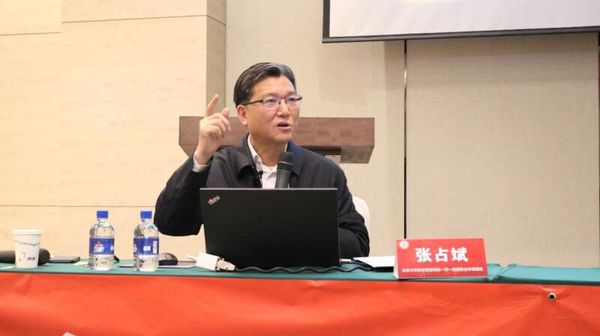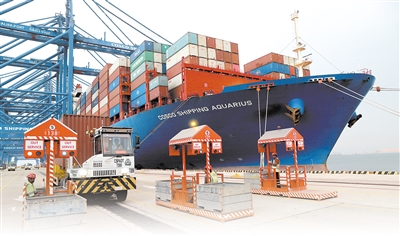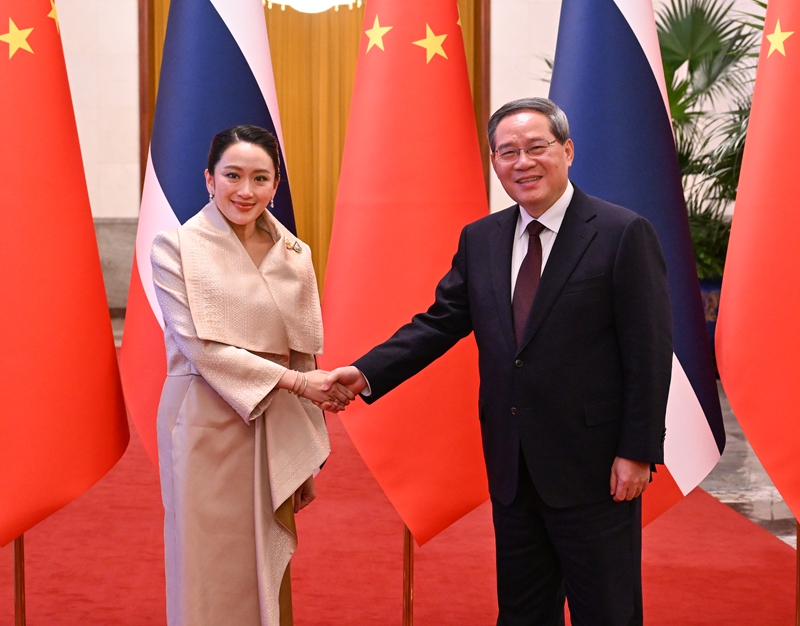Du Xiaodong: The Internal Logical Connection Between The Construction Of The "Belt And Road" And China's "Traveling And Helping" Culture
Du Xiaodong: The Internal Logical Connection Between The Construction Of The "Belt And Road" And China's "Traveling And Helping" Culture
Among them, the cultural core of "passing on the help of help", "big help small", "old bring new", and "strong bring weak", as an important part of China's traditional social ethics and philosophy of dealing with the world, provides profound cultural support and value guidance for the construction of the "Belt and Road".
The internal logical connection between the construction of the "Belt and Road" and China's "Traveling and Helping" culture
Du Xiaodong
As an important measure for China's all-round opening up in the new era, the "Belt and Road" initiative not only contains the concept of modern international cooperation, but is deeply rooted in the soil of China's excellent traditional culture. Among them, the cultural core of "passing on the help of help", "big help small", "old bring new", and "strong bring weak", as an important part of China's traditional social ethics and philosophy of dealing with the world, provides profound cultural support and value guidance for the construction of the "Belt and Road". The two are not simple cultural associations, but form an internal logical relationship of "the concept is the same origin, the practice is the same, and the goals are the same", and jointly shape the international cooperation paradigm with Chinese characteristics.

1. The same origin of concepts: the value of traditional "transmitting and helping" culture and the "Belt and Road"
The traditional Chinese "transmitting and helping" culture originates from the survival needs of the farming society and the ethical norms of the patriarchal system. The core is based on the value orientation of "symbiosis" and "mutual assistance", emphasizing the support of the advantageous parties to the weak parties, the transmission of experience and the cultivation of abilities. This culture is not a one-way gift, but is based on the Confucianism of "they want to stand up and the others, and the one wants to achieve success" and pursues a win-win pattern of "everyone has its own beauty and share beauty", which is highly consistent with the core values of the "Belt and Road" initiative.
From the perspective of ideological source, the ethical foundation of the "transmitting and helping" culture is in the same line with the cooperation concept of the "Belt and Road". Confucianism advocates that "the benevolent loves others" and advocates that the strong should bear the social responsibility of "respect the elderly and the elderly of others, and the young of others". This spirit of "altruism" and "responsibility" has been transformed into equal respect and pragmatic assistance to developing countries in the construction of the "Belt and Road". For example, the railway projects that China has assisted in Africa are not simply project output, but supporting the construction of vocational skills training schools to cultivate railway operation and maintenance talents for the local area. This is the modern international version of "leading capabilities" and "transmitting experience" in "transmitting help".
At the same time, the traditional cultural logic of "big help small, old lead new" echoes the corrective concept of the "Belt and Road" for the imbalance of globalization. In China's traditional business ethics, time-honored enterprises will teach business skills to emerging merchants, and strong merchants will provide financial turnover support for small and medium-sized merchants. This "support for the weak" does not weaken their own advantages, but achieves "rise" by cultivating a common market. Nowadays, facing the current situation where some countries are excluded from the dividends of globalization due to weak infrastructure and lagging industrial foundations, the "Belt and Road" has priority to infrastructure connectivity, helping developing countries in the "Belt and Road" to make up for development shortcomings. It is to apply the traditional "strong and weak" cultural wisdom to international governance and promote globalization from the one-way output of "center-edge" to the coordinated development of "multi-symbiosis".

2. Practical isomorphism: The concrete implementation of the "transmitting and helping" culture in the construction of the "Belt and Road"
The construction of the "Belt and Road" is not an abstract concept output, but a transformation of the practical logic of the traditional "transmitting and helping" culture into an action plan for international cooperation through specific project cooperation, capacity docking, and people's livelihood assistance. From project promotion to capacity building, from short-term assistance to long-term cooperation, the cultural core of "passing and helping" is integrated into every link of the "Belt and Road" in a perceptible and touchable way.
In the field of infrastructure construction, "transmission and help" is reflected in the full-chain assistance model of "integrated construction and operation". The traditional "transmitting and helping" emphasizes "not only giving fish, but also giving fish." China has always adhered to the integrated idea of "construction operation training" in the "Belt and Road" project. Taking the China-Laos Railway as an example, during the project construction period, Chinese enterprises trained thousands of railway technical workers for Laos, covering multiple fields such as track laying, signal control, and locomotive driving. After the railway was opened, the Chinese team continued to operate with Laos personnel and taught core technologies such as dispatching and command, equipment maintenance through the "master-apprenticeship". This model breaks the short-term behavior of Western aid to build "focus on construction and neglect operations". Just like the "master leads apprentices" in traditional handicrafts, it realizes the in-depth transmission of technology and capabilities, making Laos leapt from a "country without railways" to a country with a modern railway operation system.
In the field of industrial cooperation, "transmission and help" is manifested as a gradient cultivation of "industrial chain collaboration". As a major manufacturing country, China combines some mature production capacity with the resource endowments and labor advantages of countries along the route, and cultivates a complete industrial ecology for the local area by jointly building industrial parks. For example, as a landmark project of the "Belt and Road", the China-Belarus Industrial Park not only brings funds and technology, but also introduces supporting enterprises in the upstream and downstream industrial chains into the park, and provides Belarusian employees with full-process training from production operations to enterprise management. This model is like the "big business-driven small workshops" in traditional business. Through the "transmission and help" of the industrial chain, Belarus has gradually gained high-end manufacturing capabilities and achieved the transformation from a "resource exporter" to a "manufacturing country".
In the field of people's livelihood assistance, "passing on help" has been transformed into "small and beautiful" precise assistance. The traditional "transmitting and helping" is not only reflected in major affairs, but also permeates the daily life of neighbors' mutual assistance and neighbors' mutual assistance. The construction of the "Belt and Road" also focuses on "people's livelihood projects" that are close to the needs of local people. For example, in the agricultural demonstration center built in Africa, Chinese agricultural experts teach local farmers the technology of rice planting and vegetable greenhouses to help them increase grain output; in the "Bright Tour" activity carried out in Southeast Asian countries, Chinese doctors not only provide free surgery for cataract patients, but also train ophthalmologists for local hospitals, so that "Bright" can be transmitted continuously. These "small and beautiful" projects are like the warm continuation of "neighborly help" in traditional society, allowing the cooperation results of the "Belt and Road" to truly benefit ordinary people.

3. The same goal: cultural sublimation from "symbiosis" to "community of shared future for mankind"
The ultimate goal of the traditional "transmitting and helping" culture is to build a community relationship of "watching and helping each other, living and prospering together"; and the long-term vision of the "Belt and Road" initiative is to promote the construction of a "community with a shared future for mankind." The two are in line with their goals. The former is the concept of a "small community" in traditional Chinese society, and the latter is the concept of a "big community" facing the world. The "transmitting and helping" culture provides a ground-based cultural path and practical paradigm for a "community of shared future for mankind".
In traditional Chinese society, "transmitting and helping" is an important link to maintain community stability and development. In the countryside, elders teach farming skills to younger generations to ensure the continuation of grain production; in the clan, clan leader passes on clan rules and family mottos to clan members to maintain family harmony and unity; in the industry, masters pass on skills and skills to apprentices to ensure that the industry is passed down from generation to generation. This "symbiotic" relationship formed by "transmitting and helping" allows individuals to gain support in the community and enable the community to develop through mutual assistance. The "community of shared future for mankind" proposed by the "Belt and Road" initiative expands this concept of "symbiosis" from traditional Chinese society to a global scope, advocates that countries transcend national boundaries, races and cultures, and achieve common development through mutual assistance.
Judging from the practical results, the construction of the "Belt and Road" is transforming the concept of "community with a shared future for mankind" into reality through the "transmission and help". In Southeast Asia, China and ASEAN countries have jointly built the "Digital Silk Road" to share 5G technology and smart city solutions to help ASEAN countries achieve digital transformation; in the Middle East, China has cooperated with Saudi Arabia, Iran and other countries to build petrochemical parks, which not only improves the local industrial level, but also allows Middle Eastern countries to gradually get rid of their dependence on oil exports through technology transfer; in Europe, China and Central and Eastern European countries have made Central and Eastern European countries a new engine of European economic growth through capacity docking and infrastructure interconnection. These cooperation cases, like the social symbiotic relationship built by traditional "passion and help", are forming a community of interests around the world with "you have me and I have you".
At the same time, the "equality" and "respect" in the "transmitting and helping" culture also provide value guarantees for the construction of a "community with a shared future for mankind". The traditional "passing and helping" is not a "condescending" charity, but a mutual assistance based on equal relations. Although there is a difference between master and apprentice, big business names and small workshops, there is no difference between status. This concept of equality is reflected in the construction of the "Belt and Road" as the principle of "consultation, joint construction and sharing". China never imposes its will on other countries, but respects the development willingness and path choices of countries along the route, and jointly plans projects, promotes construction and shares the results with all countries. For example, in the construction of the China-Pakistan Economic Corridor, China and Pakistan fully negotiated and expanded the project focus from energy and transportation to areas such as agriculture and education in accordance with Pakistan's development needs, thus truly realizing equal cooperation that is "oriented towards the other party's needs".
4. Conclusion: The dialectical unity of cultural genes and practice of the times
The logical relationship between the construction of the "Belt and Road" and the traditional Chinese "transmitting and helping" culture is essentially a dialectical unity of Chinese cultural genes and the development needs of the times. The "Traveling and Helping" culture is not a rigid historical heritage, but a cultural wisdom with strong vitality formed after thousands of years of precipitation; the "Belt and Road" is not a simple economic cooperation initiative, but an international cooperation paradigm carrying China's cultural values.
At a time when globalization is facing countercurrents and unilateralism is rising, the concepts of "mutual assistance", "symbiosis" and "win-win" contained in the "transmission and help" culture provide a Chinese solution to solve the imbalances in global development and governance difficulties. By transforming this cultural core into concrete cooperative practice, the construction of the "Belt and Road" not only allows China's development achievements to benefit more countries, but also shows the world a new international cooperation model different from the logic of Western hegemony - not a competition of "zero-sum game", but a win-win situation of "1 1>2"; not a dominance of "strong people leading", but a responsibility of "strong leading the weak"; not an output of "civilization superiority", but an inclusion of "mutual learning between civilizations".
From the sound of camel bells on the ancient Silk Road to the steel dragons of today's "Belt and Road", China's traditional "transmitting and helping" culture has always been the spiritual bond connecting China with the world. In the future, with the continuous advancement of the construction of the "Belt and Road", this cultural core will continue to exert its unique value, promote the construction of a more fair, reasonable, universal and win-win global governance system, and write a more exciting chapter for the common development of mankind. (Author Du Xiaodong, alias: Mr. Belt and Road, is the chairman and director of the Chongqing Belt and Road Economic and Technical Cooperation Center, the founder of the Belt and Road Portal, the dean of the Belt and Road Research Institute of Chongqing University of Foreign Economic and Trade, visiting professor at Southwest University of Political Science and Law, visiting professor at Chongqing University of Foreign Economic and Trade, master's supervisor at Chongqing University of Science and Technology, master's supervisor at Chongqing Jiaotong University, etc.)
Edited and compiled by: Service Trade Officer





